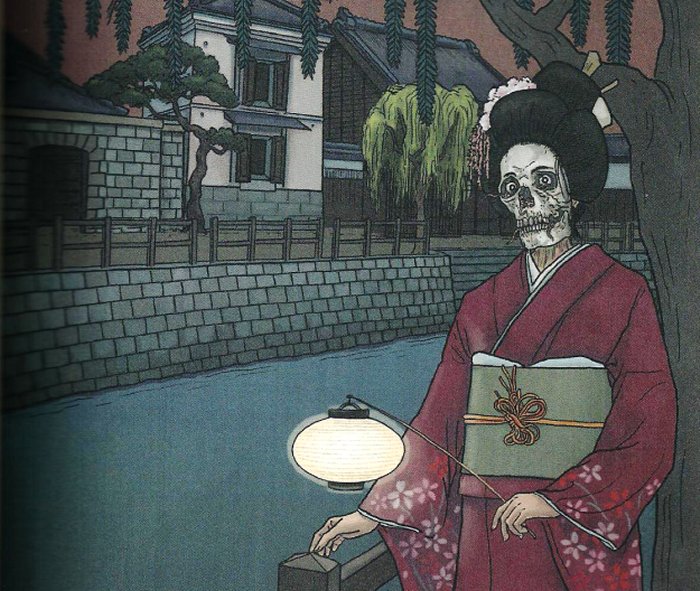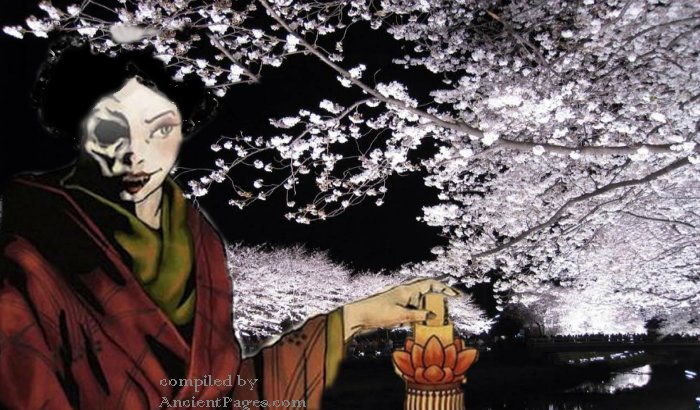A. Sutherland - AncientPages.com –The belief in Yokai (Yōkai) was mentioned in “Shoku Nihongi” text dated to the eighth-century. This ancient belief is still alive in Japanese modern society.
Yokai monsters that can take many different forms are mostly associated with abandoned places, villages, deserted mountain regions, and even other unexpected places. There are numerous Yokai in folklore, legends, and Japanese mythology.
The whole Yokai concept is quite broad because it includes creatures depicted as plants, people with various body deformations, specters, ghosts, demons and other difficult to identify monsters. They usually have abnormal strength and supernatural powers.
In a way, they are nowadays even more popular than in ancient times, as we can find them in Japanese anime, video games, movies, and manga in form of comics, cartooning, and graphic novels.
Today’s article is devoted to Hone-Onna (‘skeleton woman’), a Yokai, often depicted as an aged female that would carry a lantern decorated with beautiful peony (botan) flowers.
The main idea of many Japanese legends about Hone-Onna is always almost the same. She regularly visits the house of a man and they spend the night together, but her plan is simple. She dedicated herself to cheating, attacking and finally killing men. However, the legends have many versions.
One old Japanese version of the story tells about a widowed samurai, named Ogiwara Shinnojo who meets a beautiful woman named Yako.

They enjoy each other and meet every night, and the story seems very romantic, but there is a problem.
One night, Shinnojō’s next-door neighbor catches a glimpse of his partner and surprisingly sees the strange, shocking scene of Shinnojō embracing with a skeleton.
Could Yako be only a pretty-looking woman in the eyes of Shinnojō and for others around her, was she an ugly, aging woman?
See also:
Demon Oni: Cruel Harbinger Of Disease And Misfortune In Japanese Folklore
Nurikabe: Trickster That Manifests Itself As Invisible, Impassable Wall In Japanese Old Beliefs
Is The Legendary Tsuchinoko Real?
Yuki-Onna ‘Lady Of The Snow’: A Female Demon And Symbol Of Death In Japanese Mythology
Hone-Onna is a skeleton with an enormous appetite for sex and death. According to legends, she can take two quite different forms, the first, a beautiful woman of beautiful figure and, the second, a human skeleton.
Her charm and beauty help to seduce men. Usually, Hone-Onna takes revenge on her wrongdoers; she steals the men’s energy and vitality intentionally, and her choice of a night partner is rarely accidental. This bizarre relationship can continue for days or even weeks without being noticed. The men are so fascinated by Hone-Onna that they do not see the true appearance of this evil Yokai. Unaware that their health is in great danger and they become sicker and weaker and eventually die.
In another legend, Hone-Onna’s real name was Tsuyu. She was married to a young man, who sadly sold her to a brothel to pay off his debts.
After a while, Tsuyu and a friend, Kion, decided to escape from that brothel. It was then that her best friend, Kion, betrayed her and made her lover end Tsuyu’s life.
They threw her body into a lake (or river). Legend has it that Tsuyu’s corpse absorbed the souls of other women who had died in the same way and whose bodies were already at the bottom of that river.
As a result of this merger, she became a Yokai, Honne-Onna who dedicated herself to cheating men, attacking, and finally killing them.
Written by – A. Sutherland - AncientPages.com Senior Staff Writer
Copyright © AncientPages.com All rights reserved. This material may not be published, broadcast, rewritten or redistributed in whole or part without the express written permission of AncientPages.com






